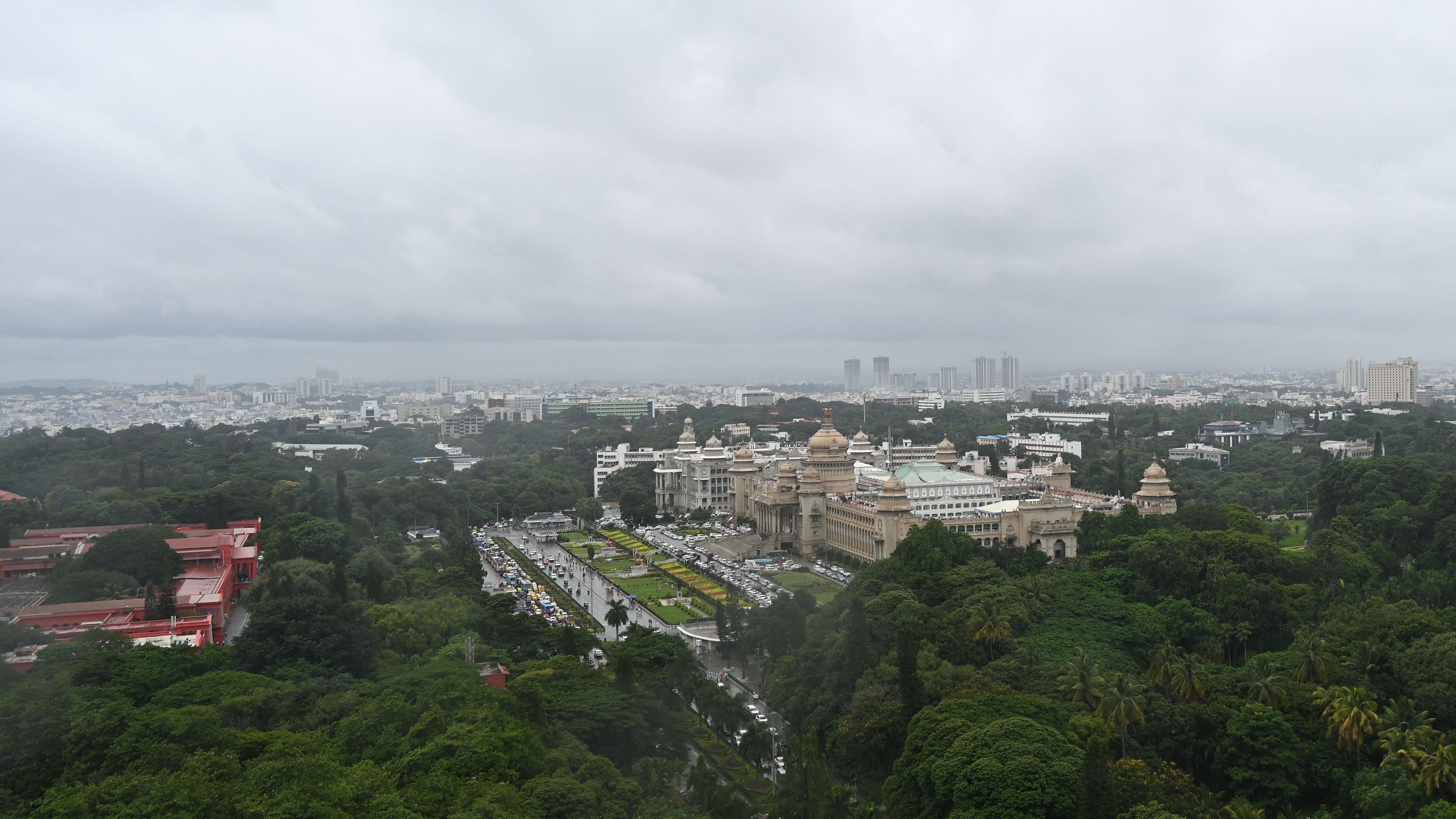
An aerial view of cloudy weather of the city during monsoon season over Vidhana Soudha in Bengaluru.
Credit: DH Photo
The Greater Bengaluru Governance Bill (GBGB), 2024, placed before the Assembly on July 23, and its draft version by the Brand Bengaluru Committee, were both not first made public as required under Section 4(1)(c) and (d) of the Right to Information Act, keeping the citizens in the dark about a matter that deeply affects them.
The reported versions of the Bill suggest that the sole aim of the GBGB is to discard the 74th Constitutional Amendment Act (74th CAA). The 74th CAA mandates “Power to the People,” devolution of powers from the second to the third tier of government -- the BBMP -- empowering it to be a ‘local self-government’. Instead, the state government—the second tier—its ministers and the parastatals under it will take complete charge of the planning, governance, and funds of Bengaluru through the Greater Bengaluru Authority (GBA) with the CM at its head.
Contrary to the claim that splitting BBMP into multiple corporations (up to 10) is necessary because the “city has become unmanageable under a single corporation,” the hidden aim seems to be to destroy the single identity of the city with a single powerful mayor. Ten mayors, each ruling only parts of the city, will be powerless to assert their right to self-governance before the overbearing state government ministers in the GBA.
If decentralisation is the goal, the existing Bruhat Bengaluru Mahangara Palike (BBMP) Act already provides for several ‘zonal committees’, or mini-councils, with increased powers to manage zones under the single BBMP. These mini-councils are headed by a zonal councillor elected by the other zonal councillors, as recommended by the National Commission to Review the Working of the Constitution for managing large cities. The fact that this splitting is being carried out even after witnessing the merging of the three corporations of New Delhi into one indicates a hidden agenda. That elections to BBMP have not been held for four years further supports this.
Another other reason given for creating the GBA is the lack of coordination between BBMP and the various parastatals (Bengaluru Water Supply and Sewerage Board, Bengaluru Electricity Supply Company, etc.) working independently within the BBMP area without being accountable to it. If the aim was to create an umbrella body for all parastatals, the 74th CAA already envisages the Metropolitan Planning Committee (MPC) as a decentralised body of the third tier of government for integrated planning for large metros like Bengaluru and for consolidating bottom-up plans from the grassroots.
Under current MPC rules, the MPC is the planning body for the Bengaluru Metropolitan Area (BMA), or the Bengaluru Development Authority (BDA) area. The parastatals BDA and BWSSB are already its members. The MPC could have been expanded to include all other parastatals, along with necessary amendments. This constitutional requirement for an MPC has been sidelined by proposing the GBA as a top-down, second-tier state-level body ruling over the third tier, without any constitutional status.
That the GBA goes against the 74th CAA is evident from the fact that the 74th CAA required the draft plan of the MPC to be sent to the state government for approval. But if GBA is headed by the chief minister, he himself will be in charge of preparing the plans, in addition to all his other duties of managing the entire state.
Further, in a totally deviant manner, the GBGB is reportedly shifting the MPC to the larger Bangalore Metropolitan Region (BMR) level, comprising three districts, instead of being a body of the third tier. There is already the Bangalore Metropolitan Region Development Authority (BMRDA), headed by the chief minister for the BMR, which prepares the structure plan, coordinates, and supervises the development of the BMR. So, is this a way of making the constitutionally mandated MPC dysfunctional by making it a parallel body to the BMRDA, but which never meets, like it was kept dysfunctional by letting the BDA continue to plan for Bengaluru instead of the MPC?
To be true to the 74th CAA, the GBA should be replaced with the MPC as the umbrella body and the mayor of Bengaluru as its head to retain it as a body of the third tier. The Structure Plan of the BMRDA for the BMR under the CM at state level would provide the broad framework for the MPC’s development plan.
At the grassroots level, the GBGB reportedly continues the system of having Area Sabhas, where all voters congregate to plan for their areas, but the Area Sabha Representative is not a member of the ward committee and has no voting rights. The GBGB also continues the system of nominating the 10 ward committee members instead of letting citizens elect them, and the ward committee itself is reportedly a mere advisory body. This undermines the notion of empowering citizens through greater participation rights.
The great variations between the three laws—the Karnataka Municipalities Act for smaller cities, the Karnataka Municipal Corporations Act, and the proposed GBGB—engender gross “inequality before law” among urban citizens. There is pending public interest litigation already questioning this in the High Court. Embedding the constitutional values of the 74th CAA in a common comprehensive Act for all urban local self-governments (ULSGs) of Karnataka, with special provisions for bigger cities where required, rather
than separate Acts, is the way forward to bring true Nagar Swaraj for all urban citizens equally.
(The writer is the executive trustee of CIVIC-Bangalore)